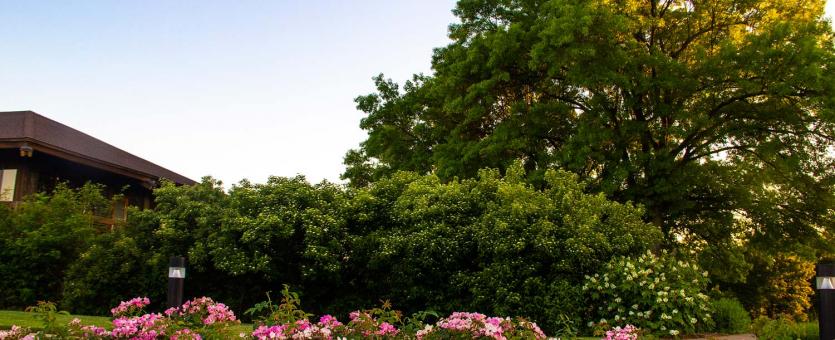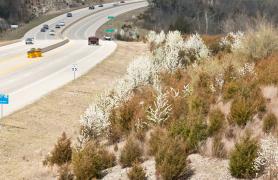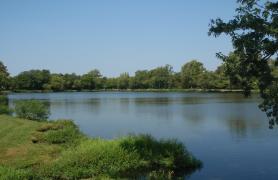
Built environments include habitats that have been created or altered by people. Most of Missouri’s lakes and ponds were built by damming rivers and streams. Roadsides, construction and industrial sites, and other places where the soil and plants are disturbed are also human-altered habitats. Even our homes and other buildings can be considered a kind of human-altered habitat.
Reservoirs Are Human-Built Lakes
Reservoirs, or impoundments, are lakes created when people block the flow of a stream by constructing a dam. The stream flow is arrested, and water pools up behind the dam and fills in the valleys or other low areas where the stream once had flowed. Large public reservoirs have turbines within them for generating electricity, and engineers can adjust the amount of water allowed to flow through them at any particular time, responding to flood threats or drought conditions.
Our many large reservoirs are major public projects implemented for recreation, flood control, hydroelectric power, and aesthetics. They are a blessing for Missouri tourism. Large concrete dams are built in strategic places in rivers, backing up (impounding) the water behind them, flooding the river valley upstream of the dam and turning it into a lake. As useful as they are for our needs, these projects create conservation challenges for many fish and other species whose natural movements up and down rivers are permanently interrupted by the presence of a dam and enormous pool of water.
Earthen dams created many smaller reservoirs appear throughout the state. Many city park lakes were built this way, and they provide people with opportunities for exercise, relaxation, and recreation. As with other reservoirs, property managers and owners need to keep an eye on the dams, making sure they are in good shape and won’t fail.
On a much smaller scale, farm ponds are created for aesthetics, fishing, and farm use. Being small and surrounded by agricultural land, the water conditions of these ponds can quickly fluctuate due to soil and nutrient runoff from the land. Where their shorelines are trampled by cattle and runoff-filtering vegetation cannot grow, they can be little more than a muddy basin. Meanwhile, well-managed farm ponds can be attractive places for fishing, bird watching, swimming, and maybe a little canoeing.
Hundreds of ponds and lakes exist on public lands administrated by MDC, the Missouri Department of Natural Resources (including state parks), the US Fish and Wildlife Service, and many cities and towns.
Roadsides, Construction Sites, and Other Disturbed Lands
A disturbed habitat is one where the natural development of a plant community is interrupted regularly or frequently. The plant community varies depending on severity and frequency of the disruption. If the disruption is both frequent and dramatic — a highly disturbed site — the plant community usually is dominated by early-successional or pioneer plants. Quick-growing plants that arrive as seeds blown on the wind, such as dandelions, are common in highly disturbed sites. Invasive and nonnative plants often abound in these places, but many native species are quick to take root, too. Examples of highly disturbed sites include the following:
- Roadsides, highway medians, railways, rail yards
- Former railways (such as along the Katy Trail)
- Parking lots, vacant lots
- Suburban yards and other places near buildings
- Crop fields, old fields, hayfields, pastures, fencerows
- Mines and industrial areas
- Construction sites
These habitats have a lot in common with stream banks and sand and gravel bars. Stream sides are great examples of naturally occurring highly-disturbed habitats, as they are continually being flooded, eroded, washed away, and built back up by the stream.
Homes and Other Structures
Usually, when we think of habitats, we think of natural places that are little disturbed by humans: woodlands, prairies, caves, and streams. But we people are continually busy creating homes for ourselves, buildings for businesses, roads, barns, bridges, and other structures — and many species are almost as comfortable in them as we are.
Why do so many animals want to move in with us? First, many animals are such generalists that they can be at home nearly anywhere. But mostly, the answer lies in how similar our human-made places are to an animal’s own natural environment. Here are some examples.
- Basements and cellars are often dark, cool, and damp, much like cave openings and other protected crevices. So cellar spiders, house centipedes, silverfish, and cave crickets are quite at home there.
- Chimney swifts originally nested in the hollow trunks of large, old trees. When settlers arrived and started building cabins with chimneys, the swifts found them acceptable habitat. Chimneys are where most of them live now.
- Peregrine falcons, and the pigeons they eat, are native to rocky cliffs, where they perched on ledges far above the ground. Today, they live in cities, with our urban skyscrapers substituting for the rocky cliff faces.
At least a few animals wouldn’t live in our homes if we weren’t there, too. Bedbugs are one example. German cockroaches are another. But in another sense, our pets are included in this category, too.
House mice, rats, house spiders, house centipedes, cockroaches, and silverfish may seem repulsive, but it is actually remarkable that they can thrive in our artificial environments. Most other animals would die if forced to live in our homes and cities for any length of time.
Fortunately, most of the animals that join us in our homes are neither destructive nor injurious to our health. We recommend consulting licensed exterminators and wildlife removal specialists for unwanted infestations and nuisance species.
Built Outdoor Landscapes
Our yards, gardens, parks, and agricultural areas are unique environments that attract certain kinds of organisms. The disturbance of soils itself promotes the occurrence of many nonnative and native weedy plant species, but then there are the plants we cultivate.
We humans often include a wide variety of exotic plants when we landscape our yards, parks, and other places. Wandering around in a suburban garden center can be the botanical equivalent of a stroll through a zoo. There, you can see exotic trees, vegetables, and flowers from all over the world, such as gingkos, Japanese maples, eggplants, spinach, petunias, and begonias.
Botanists, when determining whether to include a plant species as part of a region’s official flora, use this question as a dividing line: Does the species live and reproduce here on its own, without cultivation? Or does it only survive when people have planted and cared for it? Many nonnative plants that were initially cultivated by people can survive and reproduce here on their own. When botanists find such plants growing and reproducing untended, they count them as part of our naturalized flora. But other exotic plants only exist in cultivation — in the human-made habitats of lawns, gardens, city parks, and so on.
As to animals, birders know that many species of birds are especially attracted to parks and yards, or to pastures, farmyards, cropfields, and other agricultural areas. And people who live in towns know that raccoons, squirrels, opossums, and other mammals can thrive in the human-built environment of our own neighborhoods.























